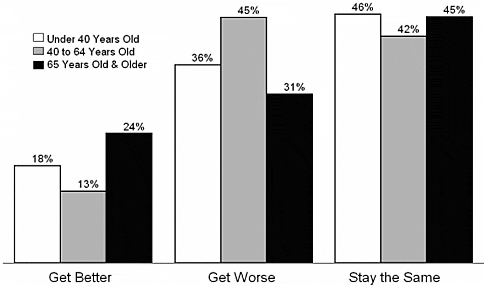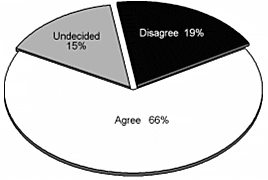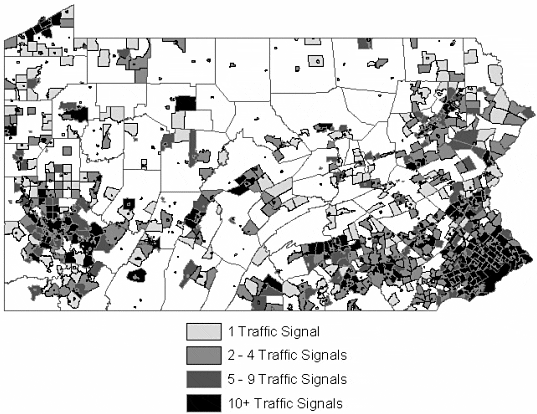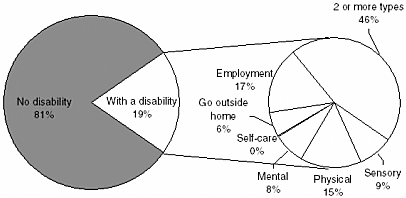Newsletters
- Home
- Publications
- Newsletter Archive
- Newsletter
November/December 2004
Inside This Issue:
- Survey Reveals Rural Attitudes on Economy, Environment, Government and More
- Chairman’s Message
- Research Offers Insights into Health, Nutrition of Migrant Farm Workers
- Seeing Red, Yellow and Green: Counting All Traffic Signals
- Did You Know . . .
- Survey of Domestic Violence Victim Service Agencies
- Just the Facts: Rural Residents with Disabilities
Survey Reveals Rural Attitudes on Economy, Environment, Government and More
Rural residents are less satisfied with the way things are going in Pennsylvania and more pessimistic about the future of the state’s economy than they were in 1999, according to the results of a study sponsored by the Center for Rural Pennsylvania.
The study, conducted in 2003 and based on the responses of 1,737 rural residents, determined the current attitudes and perceptions of rural Pennsylvanians related to the economy, government, the environment, and other issues. It assessed changes over the last few years by comparing the results to the 1999 Center for Rural Pennsylvania baseline survey and two others carried out by other organizations since 1999.
The research was conducted by Dr. Fern K. Willits, Dr. A.E. Luloff, and Dr. Francis X. Higdon of Penn State University.
State-level issues
As noted above, compared to 1999, the 2003 respondents were less satisfied with the way things were going in Pennsylvania and more pessimistic about the future economy of the state. In 1999, 88 percent were somewhat or very satisfied with the way things were going in the state; in 2003, 68 percent were similarly satisfied.
In 1999, 33 percent believed the economy would get better in the next year or so and only 18 percent thought it would get worse. In 2003, 16 percent felt the economy would improve in the next year or so, while 39 percent believed it would get worse.
Overall, more than 80 percent of respondents felt that the availability of jobs and health care are issues that should receive higher priority in the future than they currently have. The percentages increased between 2000 and 2003 from 76 to 87 percent for availability of jobs and from 78 to 81 percent for health care. In 2003, at least 60 percent wanted higher priority for crime and violence, care of the elderly, education for youth and children, drug and alcohol abuse, safe drinking water, safe disposal of industrial wastes, and reform of the state’s local tax structure. About one fourth felt that construction of new highways and access to telecommunications and the Internet should have lower priority.
To create jobs and develop Pennsylvania’s economy, rural Pennsylvanians saw high merit in providing incentives to industries, increasing worker skills, and promoting small businesses but not for expanding web-based e-commerce, promoting tourism in rural areas, or lowering environmental standards to attract industry. Furthermore, between 2000 and 2003, the proportion indicating that high priority was needed to promote small businesses, provide incentives for expansion of existing businesses, and promote the development of large businesses increased significantly.
Local community issues
Sixty-eight percent of respondents had lived in their present communities 15 years or more, with 28 percent having lived there all their lives. Although rural people overwhelmingly felt that their communities were desirable places to live and felt safe living there, the proportion of such positive responses declined somewhat across time.
The lowest ratings of communities were in terms of job opportunities, community leadership, health care, citizen involvement, and recreation.
Rural Pennsylvanians indicated that high priority should be given less to improving local facilities, access to computers and public transportation, and more to family and human service issues, such as strengthening public schools and attracting health care workers.
Land use issues were an interesting paradox. While rural Pennsylvanians gave priority to maintaining open space in their communities, they were ambivalent about municipal land use regulation and planning. Seventy-two percent agreed that local government should regulate changes in land use to limit negative impacts on the community. However, 51 percent indicated that property owners should have an unrestricted right to use and sell their land as they see fit.
General social issues
Respondents overwhelmingly supported four of the 12 general social issues posed in the survey. At least 70 percent agreed that public school teachers should be required to periodically pass performance tests to retain their certification to teach, students should be required to pass a test of basic skills for high school graduation, public school teachers should be prohibited from going on strike during the school year, and the death penalty should be maintained.
Meanwhile, about 60 percent opposed both giving same-sex domestic partners the same legal rights and benefits as married couples and eliminating criminal penalties for the possession and use of marijuana, and 53 percent opposed Sunday liquor store sales.
Also supported though not as strongly were: the current flat rate state income tax should be changed to a graduated tax rate; tax-supported after school activities should be provided for children and youth; casino gambling should be legalized; and doctors should be legally permitted to help terminally ill patients end their lives.
A few changes from 2000 to 2003: support for legalizing casino gambling increased from 36 percent to over 50 percent; support for same-sex domestic partners having the same legal rights and benefits as married couples increased from 20 to 25 percent; and support for providing tax-supported day care for children declined from 52 to 43 percent.
While rural Pennsylvanians shared many views about a wide range of state and local issues, there were also important differences in their attitudes and perceptions depending upon their socio-demographic characteristics, such as age, gender, education, and income, and, to a lesser extent, the characteristics of the counties in which they lived.
Computer and Internet access
Sixty-six percent of respondents had computers in their homes in 2003, and an additional 8 percent had access to a computer at work, a library, a school, or another location. One in four did not have such access. Almost everyone who had a home computer also had an Internet connection of some kind (94 percent). However, counting those who did not have a home computer, 38 percent of all subjects did not have Internet access from home and 30 percent were unable to access the Internet at all.
Respondents with computers at home increased from less than half to nearly two-thirds since 1999 and Internet access from home doubled.
Computer use and Internet access have increased markedly during the last five years, but sizable numbers of people do not use electronic communication and web access daily. Moreover, the priority that rural Pennsylvanians gave to expanding telecommunications and Internet access and to expanding web-based employment opportunities was relatively low; only 15 percent indicated that higher priority should be given. Likewise, just 23 percent felt that communities should give high priority to providing opportunities for computer training and just 16 percent reported that priority should be given to providing public access to computers.
Conclusions
Economic growth and the expansion of jobs is the most pressing issue facing many rural residents. The emphasis given to increasing job availability has supplanted much of the public’s concern about other matters, including the priority given to many environmental and social issues. Interestingly, while work-related priorities were clearly most important to rural Pennsylvanians, there was little support for expanding web-based e-commerce or promoting rural tourism.
There were clear distinctions between female and male rural residents’ perceptions about the importance of state-level policy issues. Women were more likely to indicate a higher priority than men for availability of jobs, health care, crime and violence, care of the elderly, education for youth and children, drug and alcohol abuse, safe drinking water, safe food supply, cleaning up polluted sites, homeland security/public safety, air quality, and child care. Only for reforming Pennsylvania’s local tax structure did men indicate a higher preference than women.
One trend revealed in the study was an increasing level of dissatisfaction and pessimism among rural Pennsylvanians regarding their current and future economic prospects. Between 1999 and 2003, there was a 20 percentage point decrease in rural residents reporting that they were satisfied with the way things were going in the state, and a similar increase in the proportion who believed the state economy would get worse in the next year or so. Despite high levels of satisfaction with local quality of life, many residents continue to face declining employment prospects.
Report available
For a copy of the report, 2003 Attitudinal Survey of Pennsylvania Rural Residents, call the Center for Rural Pennsylvania at (717) 787-9555 or email info@ruralpa.org.
Gauging the Economy

Data source: 2003 Attitudinal Survey of Pennsylvania Rural Residents
Rural Areas Provide Fewer Opportunities for New Experiences Than Other Areas

Data source: 2003 Attitudinal Survey of Pennsylvania Rural Residents
Chairman’s Message
As the Center for Rural Pennsylvania, we are interested in the opinions of rural residents in the Keystone State. In order to gauge these opinions and put them into context for future comparisons, the Center sponsored a statewide attitudinal survey in 1999 to establish a baseline for rural opinions and attitudes across a wide spectrum of issues, including the economy, the environment, government, personal well-being, computer use, and others.
In 2003, the Center sponsored a follow-up study to continue building on this baseline information. The results provide interesting insights on rural viewpoints.
The economy and jobs are among the top concerns for rural Pennsylvanians. The events of September 11, 2001 that divided the time span between the surveys have had far-reaching impacts on every aspect of our lives, whether rural or urban.
The Center’s most recent survey found rural Pennsylvanians continue to be satisfied with their local quality of life, but are less optimistic about current and future economic prospects.
The report, 2003 Attitudinal Survey of Pennsylvania Rural Residents, was conducted by Dr. Fern K. Willits, Dr. A.E. Luloff, and Dr. Francis X. Higdon of Penn State University and offers many more insights into rural Pennsylvanians’ thoughts on the environment, government, and social issues. Call or email the Center for Rural Pennsylvania to request a copy of the full report.
Pennsylvania’s agricultural industry relies on migrant and seasonal farm workers for crop production, especially in the fruit and mushroom areas. Researchers from Penn State University conducted several focus groups of service providers and migrant and seasonal farm workers in Adams and Chester counties in order to gather information about the workers’ health, nutrition, and food shopping, food preparation and eating habits. The results of this Center-sponsored mini-grant are found in this edition of Rural Perspectives on page 4.
Many of us spend many hours during the holidays traveling our Commonwealth’s highways. If driving is part of your tradition, you may want to supplement the verses of “Over the river and through the woods” or spelling the alphabet with road sign words by observing the red, yellow, and green colors of rural traffic signals with a new perspective. If your appetite for more details has been cultivated, turn to the article on page 5 of Rural Perspectives.
Whatever your plans may be over the holiday season, please remember to give thanks for the blessings that we receive every day, and for the bounty that our farmers’ hard labor provides whenever we sit down for a meal. Happy holidays and New Year.
Representative Sheila Miller
Research Offers Insights into Health, Nutrition of Migrant Farm Workers
Each year, approximately 45,000 to 50,000 migrant and seasonal farm workers are employed in Pennsylvania to assist in harvesting the Commonwealth’s fruit, vegetable, and mushroom crops*.
While the efforts of migrant and seasonal farm workers allow the U.S. population access to high quality and affordable foods, these workers may suffer from food insecurity, malnutrition, poor health status, poverty, and low job security, and may live and work in unsafe and unsanitary conditions.
A recent Center for Rural Pennsylvania mini-grant study, conducted by Dr. Katherine L. Cason, Dr. Anastasia Snyder and Dr. Leif Jensen of Penn State University, explores the health and nutrition of migrant and seasonal farm workers in selected counties of Pennsylvania.
The study, which was conducted in 2003, used key informant interviews and focus groups to gain insight into the health and nutrition of a small sample of Hispanic migrant and seasonal farm workers in Adams and Chester counties. The findings from this study indicate that this population is diverse and varies from county to county but consists mainly of Spanish speaking workers from Mexico. Some are settled, while others follow a migrant stream originating in Florida and moving on to New York or Indiana after working in Pennsylvania.
Migrant health issues
According to the key informants, the farm workers suffer from a variety of health issues. The most frequently mentioned conditions were diabetes, poor dental health, heart disease, obesity, anemia, and depression among women and teens. Nutrition and diet-related diseases are major health issues that the migrant farm workers and their families face.
The migrant farm worker focus group discussions about favorite foods provided insight into the dietary acculturation of the participants. This acculturation process is usually accompanied by environmental and lifestyle changes that can markedly increase chronic disease risk, including the adoption of dietary patterns that are high in fat and low in fruits and vegetables. Participants in all focus groups mentioned that their eating habits have changed dramatically since being in the U.S. in ways that include not eating as many fresh fruits and vegetables. All participants stated that they have increased their consumption of foods from fast food and buffet restaurants.
The food sufficiency practices mentioned were sharing with friends and family, not eating or drinking certain foods and beverages because of the cost, eating an abundance of beans, rice and tortillas, buying food on sale, eating less, and making good use of leftover foods. None of the participants mentioned participation in food assistance programs, such as food stamps, WIC, soup kitchens, churches, or food banks.
Barriers to care
The migrant and seasonal farm worker population faces barriers to adequate care that go beyond the inadequate transportation, illiteracy, and lack of insurance experienced by other low-income rural populations. This population group is not proficient in the English language, is less educated, and earns less money. In addition, other unique barriers to care include lack of knowledge about available services; lack of understanding of health problems and risks; lack of knowledge of the importance of preventive care; lack of understanding of the U.S. health care system; cultural and linguistic differences with care providers; and fear or mistrust of the health care establishment or governmental assistance.
The participants expressed a need for information about how to feed babies and children, how to make more nutritious and cheaper food, how to use American foods, weight loss information for both children and adults, and information about diabetes. All mentioned that nutrition education programs should be fun, interactive and presented in Spanish, and should involve cooking.
Regarding the migrant farm worker population, the researchers offered several policy considerations that address awareness issues, information systems, collaborative services, and health and nutrition education.
Copy of report available
For a copy of the report, The Health and Nutrition of Hispanic Migrant and Seasonal Farm Workers, call the Center for Rural Pennsylvania at (717) 787-9555 or email info@ruralpa.org.
Note: The lack of accurate data on the number of farm workers is a nationally recognized problem (Larson, Findeis, Swaminathan, and Wang, 2002). The exact number of migrant and seasonal farm workers in Pennsylvania is unknown because these data are not systematically collected. This figure comes from Rural Opportunities, Inc., a statewide service organization that targets this population and keeps records of those served.
Seeing Red, Yellow and Green: Counting All Traffic Signals
For motorists in a hurry, red is probably not their favorite color. In rural areas, however, tardy motorists don't see red as often as urban motorists since there are fewer traffic signals in rural Pennsylvania.
According to data from the Pennsylvania Department of Transportation (PennDOT), in 2004, there are 2,238 traffic signals in rural Pennsylvania, or 16 percent of the state’s nearly 13,660 traffic signals. On average, this works out to one traffic signal for every 31 miles of highway in rural Pennsylvania. In urban areas, the average is one signal for every five miles of highway.
Except for Forest and Perry counties, which have no traffic signals, every rural county has at least one traffic signal. Other rural counties with very few signals are Juniata and Potter, with three each; Cameron and Fulton, with two each; and Sullivan, with one. Among urban counties, the most traffic signals are found in Philadelphia (2,959 signals), Allegheny (1,517 signals), and Montgomery (1,385 signals).
Within rural Pennsylvania, a motorist is most likely to encounter traffic signals in a township; 75 percent of the traffic signals are in townships and 25 percent are in boroughs.
Statewide, outside of Philadelphia and Pittsburgh, traffic signals are split nearly evenly between townships and boroughs/cities. Statewide, 51 percent of traffic signals are in townships, and 49 percent are in boroughs and cities.
Number of Traffic Signals by Municipality, 2004
(No shading = no traffic signals)

Prepared by the Center for Rural Pennsylvania
Data source: PA Department of Transportation
Did You Know . . .
- Rural areas have more florists, per capita, than urban areas. In 2001, rural areas had 10.5 florists for every 100,000 residents, while urban areas had 9.4 florists for every 100,000 residents. (2001 County Business Patterns, U.S. Census Bureau)
- Rural areas have more video/DVD rental stores, per capita, than urban areas. In 2001, rural areas had 6.2 video and disc rental establishments for every 100,000 residents, while urban areas had 5.3 for every 100,000 residents. (2001 County Business Patterns, U.S. Census Bureau)
- In 2001, rural areas had 8.4 hardware stores for every100,000 residents, while urban areas had 4.5. (2001 County Business Patterns, U.S. Census Bureau)
Survey of Domestic Violence Victim Service Agencies
Domestic violence and sexual assault know no boundaries. According to the Pennsylvania Coalition Against Domestic Violence and the Pennsylvania Coalition Against Rape, in 2003, more than 39,300 rural residents sought assistance, or 11.6 clients for every 1,000 rural residents. In urban areas, nearly 94,400 persons sought assistance, or 10.6 clients for every 1,000 urban residents.
Statewide, this assistance was provided by 81 local domestic violence (DV) and sexual assault (SA) agencies. These agencies assist clients with counseling, medical and legal accompaniment/advocacy, referrals to other agencies, and additional services. To provide these services, local agencies receive both federal and state funding, along with donations from county government, community groups, businesses and individuals.
The Center for Rural Pennsylvania was interested in learning more about the unique challenges and opportunities facing rural DV and SA agencies and in comparing rural agencies to urban agencies.
In February 2004, the Center surveyed the directors of the state’s 81 domestic violence and sexual assault service agencies. The survey response rate was 43 percent, and respondents included both rural and urban providers. While the sample size was relatively small, the survey revealed that rural agencies face financial and community awareness challenges. It also found that rural and urban directors differ in their opinions on how SA and DV cases are handled by the police, medical professionals, and courts.
For a copy of the survey results, Survey of Domestic Violence, Sexual Assault Victim Service Agencies, call the Center for Rural Pennsylvania at (717) 787-9555 or email info@ruralpa.org.
Just the Facts: Rural Residents with Disabilities
Nearly one in five residents in rural Pennsylvania, or 626,304 persons, were living with disabilities in 2000. Almost half of these individuals (46 percent) had more than one disability. The most common type of disability was employment followed by physical, sensory, and mental.
Disabilities show up in varying rates among persons of different genders and ages. For example, males made up the majority of persons with disabilities in younger age groups and females made up the majority among those age 65 and older.
Six percent of children between the ages of 5 and 15 had a disability compared to 17 percent of the working age population and 41 percent of seniors.
Disability type is greatly dependent on age. Excluding those with multiple disabilities, children most commonly had mental disabilities while seniors were most likely to have physical disabilities. As may be expected, the older people were, the more likely they were to have more than one type of disability.
Disability status definitely has an effect on employment status. Of the approximately 375,000 rural Pennsylvania residents of working age who had at least one type of disability, 52 percent were employed. Among the working age population without a disability, 73 percent were employed.
About the data: The U.S. Census Bureau’s decennial census collects data on disabilities for the non-institutionalized population age 5 and older. Therefore, data do not include people in correctional institutions, nursing homes, hospitals and wards for the chronically or mentally ill, and juvenile or other institutions.
Disabilities are divided into sensory, physical, mental, self-care (dressing, bathing, or getting around the home), going outside the home (alone to shop or visit the doctor’s office), and employment (working at a job or business). Going outside the home is collected only for persons 16 and older and employment for those age 16 to 64.
Disability Status in Rural Pennsylvania by Type of Disability, 2000

